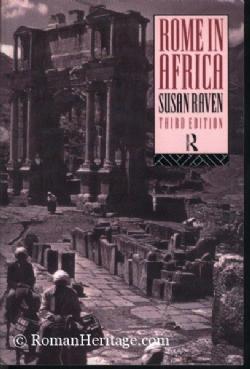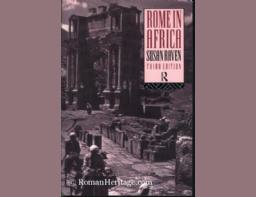RomanHeritage
is a non-profit cultural website about Ancient Rome, with Republican & Imperial Roman sites, roman ruins, Museums, books & movies, re-enactment groups, statues, Mosaics, frescoes, bronzes, etc.
Roman Heritage / Legado Romano
web sin ánimo de lucro sobre el Imperio romano, los yacimientos, ruinas romanas, museos, libros y películas, reconstrucción histórica, estatuas, mosaicos, frescos, etc.
Roman Heritage /Heredité Romaine
c'est une website sur l'empire Romain avec de Ruines romaines, museés, livres et films, groupes de reconstrucion historique, statues, mosaics et frescos.
Roman Africa

Roman Africa occupies the north of the African continent of the shores of the Mediterranean Sea, between the Atlantic coast and the “Cirenaica”. It would correspond with present-day (what is today known-as Morocco, Algeria, Tunisia, and Libia. Culturally, it is the Punic zone of influence while Egypt and “Cirenaica”, separated by two distanct deserts of Roman Africa, belong to the “Hellenistic sphere”.
This reached a total of eight provinces: Africa Proconsular (the first) in the center, “Tripolitania” and “Byzancena” in the east and in the western zone “Numidia Cirtensis” and “Military Numidia”, “Mauritania Cesariense”, “Mauritania Sitifense” and “Mauritania Tingitana”. The north of Africa is populated by Berber towns with different ways of life. Joined at the coast, fairly urbanized, are settled tribes who live off of agriculture. They grow cereals and, after the arrival of the Phoenicians, called the Mediterranean cultures they grew oranges, lemons, olives, figs or dates. More towards the interior, since they had more mobility, they dedicated themselves to sheepherding, most importantly herding livestock. In the south were the Nomadic tribes who were never truly “Romanized”.
Around 800 B.C., the Phoenician villages of the Mediterranean began to create commercial settlements in the costal zone and they mixed with the Berber population. In 814 B.C. the city of Carthage was founded, the same city that two centuries later was considered one of the most powerful in the Mediterranean. Around 500 B.C., The Carthaginians had formed an empire that extended to the Iberian Peninsula, the north of Africa, the Balearic Islands, Corsica, Sardinia, Sicily, and their commercial expeditions extended to the tropics of Africa.
Thus the Roman Empire began to expand. The conquest of new territories allowed for reliance on slave labor and less dependence on crop plants in the moment in which a large part of the agriculturists were abandoning their fields for the city. The roman streets were constructed to facilitate the swift movement of armies and trade and primarily to utilize the waterways and the Mediterranean that became the principal mode to transport goods. Carthage and Rome were faced by the dominion of the Mediterranean.
PUNIC WARS
The First Punic War (264 B.C. - 241 B.C.), was for control of Sicily, it ended with a treaty in which the Carthaginians of Amilcar Barca gave up control of the island. Just one year later Rome, taking advantage of the rebellion of the Carthaginian mercenary army, took Corsica and Sardinia. Since then the Romans called the Mediterranean "Mare Nostrum” (Our Sea).
During the Second Punic War (218 BC-201 BC), Hannibal crossed the Alps and marched to attack Rome, defeating the Romans at Trebia, Ticinus, lake Trasimene and Cannae. His brothers Hasdrubal and Mago remained in “Hispania”, and were defeated in Ilipa by Public Cornelio Escipion’s son (later known as Escipion “The African"), who defeated Hannibal himself at the Battle of Zama, 19 October 202 BC.
Finally Carthage gave up and lost all their Carthaginian trading colonies and was forbidden to have their own navy and army or to hire mercenaries in large numbers.
The Third Punic War (149 B.C. - 146 B.C.) consisted mostly of the siege on the city of Carthage, after the continuative invectives of “Caton el Viejo, monotonously repeating his "Delenda est Carthago." Publio Cornelio Escipion Emiliano (later conqueror of Numancia, called “Africano Menor” and “Numantive”) destroyed and burned the city to the ground. Carthage and its territory was converted in the first Roman province in Africa and received the name: Africa. To this day it is still a small province bounded by the “fossa regia”, a trench that the Romans built to mark their territory.
Top of Form
Bottom of Form
NUMIDIA
The expansion of Rome in Africa continued with the annexation of the King of Numidia that approximately geographically occupied the north of actual Algeria. This region of the Berber population was under the cultural and economic influence of Carthage, it was during the Second Punic War that it was divided between the various lesser allied kings or vassals of the Cartaginians. Masinisa, king of Numidia (202 B.C.- 148 B.C.), abandoned this coalition to form a pact with Escipion the African and became Rome’s main ally in this zone. For this he is recognized by the Romans as sovereign of Numidia and of the various territories taken by Carthage. Under his reign, Masinisa reunited some of the ancient kings of North Africa, setting up a society that followed the Hellenic model, promoting the settlement of the tribes, creating new cities and giving the agriculture great importance, thus maintaining good commercial relations with Greece. At his death in 148 B.C., the Third Punic War had already began, the division of his kingdom between his sons created constant confrontations that would continue later with his grandsons. Rome encouraged this discord.
In 118 B.C., Yugurta, grandson of Masinisa, fought with his cousins, assassinated Hiempsal and defeated Adherbal that requested the help of Rome. In 113 B.C., to invade Cirta, the capital of Adherbal, Yugurta killed a few Roman merchants and Rome was forced to intervene. The consul Lucio Calpurnio Bestia developed a “lightning campaign” that ended with the surrender of the Numidian King. However, the peace terms were so favorable to Yugurta that Rome promoted an investigation of alleged bribes. The war resumed under the command of Quinto Cecilio Metelo, the Mumidian, it continued for five more years until he was replaced by his lieutenant Mario. Yugurta sunk Mauritania and Rome sent Lucio Cornelio Sila there to attain the support of the king Boco 1. Yugurta is captured in 104 B.C. and, eventually executed in Rome.
The Kingdom of Numidia was divided between Boco I and the Numidian Gauda. In the War of Jugurtha Mario and Sulla began to develop their political career. After the death of Boco I of Mauritania, his children supported Julius Caesar in the Second Civil War. Juba I of Numidia on the other hand supported Pompey.
In 46 B.C., in the battle of Tapso, Cesar and his allies defeated Juba 1. Boco I from Mauritania increased his territory, Jube 1 commited sucide while Numidia annexed itself from Rome as a distinct province. The province of Africa would now come to be known as “Old Africa” (Africa Vetus) and the Numidian Kingdon became “New Africa” (Africa Nova).
In 29 B.C. a small section of the restoration for the Numidian Monarchy was produced. Octavio Augusta placed himself on the throne of Numidia of Juba II, marrying Cleopatra Selen II at the offer of a large dowry. But Juba II was considered by his subjects as excessively Romanized and this caused constant disturbances. At 20 a. AD, Juba II and Cleopatra Selene II fled to Mauritania, Rome ends with rebellions and Numidia again converted, this time for good, a Roman province. Septimius Severus will divide Numidia Cirtensis later in the north, with capital Cirta and south Militiana Numidia whose capital is the quartering of Lambese, since in this area are frequent uprisings and raids by Berber tribes that were not romanized.
Top of Form
Bottom of Form
MAURITANIA
It does not geographically correspond to the actual Mauritania, but is situated on the other side of the Atlas, what is present-day northern Morocco, Algeria and the Spanish cities of Ceuta and Melilla. It was/is inhabited by tribes of Semi-nomadic Berber Shepherds, between them and the “Mauri y los Masaselios”. En 203 B.C. the Masaselios, supporters of Carthage, were defeated by Rome and they joined the Numidian kingdom of Masinisa, allies of the Romans.
In the beginning of the 2nd century B.C., when Numidia was already a Roman province, Octavio Augusta designated the numidian Juba II king of Mauritania and the capital, Cesarea, was converted into a grand Hellenistic center. At his death he was succeeded by his son Ptolomeo, the one who was assassinated in 40 B.C. The kingdom of Mauritania is therefore annexxated and divided into two Roman pronvinces, the “Mauritania Tingitana” with the capital of Tangier (Tingis) in Morocco and the Mauritanaia Cesariense whose capital was Cherchell (Cesarea) in Algeria.
In 288 AD., the administrative reform of Diocletian separated the east of Mauritania Cesariense to create the new province with its capital in Mauritania Sitifense Sétif (Sitifis).
As what customary in Roman Africa, the Romanization was implanted solely in the costal cities or depended upon the Roman colonies. In the interior zones Romes ejercized its power throuw the local Mauritanian rulers. Because of this, Mauritania was practically independent when the Vandals arrived.
In the 5th century A.D., The Germanic village of the Vandals crossed the Straight of Gibraltar in the south of the Iberian Peninsula and invaded Roman Africa. The Vandals had been in the region for one hundred years and various Roman attempts to regain their land proved futile even though they maintained the commercial routes of the Mediterranean.
In 533 A.D., Justinian I, emperor of the Imperial Orient tried once again to reconquest Roman Africa, sending general Belisario. A century later, The Arab Muslims began the conquest of Northern Africa and thirty years later most of the region had been “Islamicized”.
Converted into the new stock of food for Rome and the main exporter of wheat, olive oil, wine, fruits, and “garum”, the Romanization of northern Africa was painfully long and in the southernmost regions the goal was never completed. Above all, it was based on the settlements of retired soldiers who became soldier-farmers mainly during the times of Claudio, Nerva, and Trajano. In the 2nd century A.D., Rome urbanized and developed the area surrounding Setif (Sitifis) but, contrarily, the occidental region was only Romaniziced along the costa and “las principales calzadas militares”.
Trajan built the Limes in the south to the southeast, with a line of fortifications from Biskra (Vescera) to Hennchir Besseniani (Ad Maiores). The limes reached Massaad (Castellum dimidia) at the southern end of the Roman Algeria but many of the fittings were made up mostly of local forces.
Top of Form
MOROCCO
_Cotta (Tangier), temples, Roman baths, mills
_Chella (Cologne Chamber) in Rabat
_Essaouira
_Fez
_Lixus (Near Larache), mosaic of the sea god
_Oualili (Volubilis, near Meknes), temple capitol, forum, streets with arcades, baths, houses with private baths, mosaics, early Christian basilica, triumphal arch of Caracalla
Rabat Archaeological _Museo
TUNISIA
_Túnez Capital (ancient Roman Carthage) and Museum
_Uthica
_Dougga (100 km from Tunis), a temple dedicated to the Capitoline Triad and ten temples, roads, villas with mosaic floors, a system of tanks for water.
_Hamamet (Pupput, Puppis Civitana) burial complex with more than two thousand graves, 3 villas with sewage, mosaics, theater, 2 baths, mosaics and early Christian
_The Jem: a Roman amphitheater in excellent state of preservation, the best in Africa and one of the best today.
ALGERIA
_Calama
_Cuicul
Veteranorum _Diana
_Iol Caesarea (Cherchel)
_Khemissa (Thubursicu-Numidanum)
_Lambaesis (Pretorio remains of the fort of the Legion)
Timgal _Madure
_Tébèssa (Theveste)
_ Thamugadi (Thimgad), Arch of Trajan
_ Tipaza (Tipasa)
LIBYA
_Bengazhi
_Cyrene, Trajano.teatro thermal baths, temples, fountains of Apollo, Ptolemaion (gym Greco-Roman), necropolis
_Leptis Magna (120 km from Tripoli) the triumphal arch of Septimius Severus new forum, baths and toilets of Hadrian, arena, Nymphaeum capitol, theater, amphitheater, Byzantine cisterns
_Sabratha, Temples, forum, capitol, toilets, baths, theater, basilica of Justinian
_Trípoli, Arch of Marcus Aurelius




